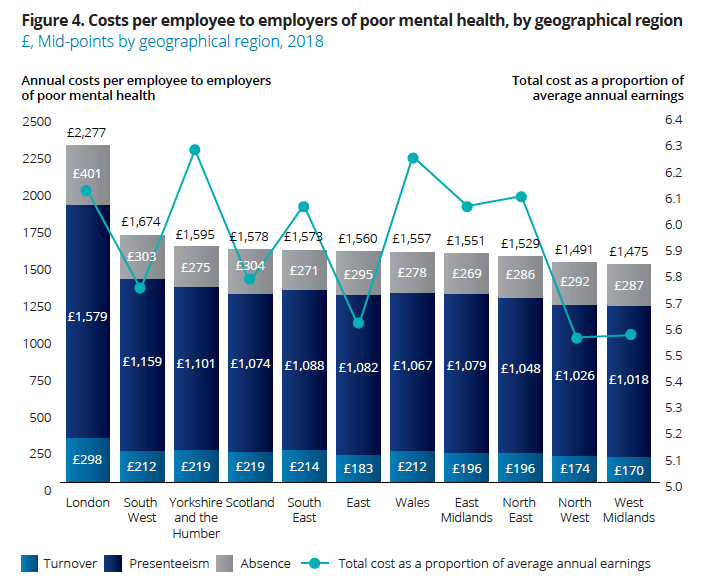The business case for mental health in the workplace
While we hope for a world that one day takes investing in mental health as much as a given as investing in physical health, the reality is that a lot of the conversation is still caught up in the statistics and the returns.
Some businesses have invested ahead of time, but for others, without a clear business case they see these initiatives as a cost rather than an investment.
While each business will have to build a case in their own way that is specific to them, there are some general pointers you can use to help; take a look at them below.
Use widely publicised studies
The best place to start is to look at the work that has been done in recent years to prove the link between investing in mental health and positive ROI. Perhaps the most useful case study is Deloitte’s Mental health and employers: Refreshing the case for investment.
At any one time, one in six employees will be struggling with their mental health. The cost of this to UK businesses, rather than heading in the right direction, has risen since 2017.
Furthermore, Deloitte found that poor mental health will, on average, cost businesses between £1475 and £2277 per employee per year.
Crucially, only around 14% of employees feel comfortable telling HR about any struggles they are having. So while the problems are there, they may be hiding in plain sight.

But the stats and facts speak for themselves; this will be affecting every business in the UK.
The flip side to this is that Deloitte also found that for every £1 a business invests in mental health, they could see up to £11 returned. That’s a pretty strong business case already!
As Paul Farmer, CEO of Mind, says “This report shows the link between prioritising staff wellbeing and improved loyalty and productivity; and decreased sickness absence and resignations”.
Using these studies to build your own mental health business case
Of course, studies that show national statistics containing hundreds of thousands of data points can sometimes be hard to relate to.
But, the major benefit of these external studies is that they’ve done half the battle for you; highlighting the problem in numerical and monetary terms and then tying this investment to a return or reward.
So use what’s already out there and start to build a case in the context of your own business.
If you have 60 employees, and you know that at any one time 1 in 6 people will be struggling, then you already know that 10 of your employees may be having a tough time of it right now.
And, let’s say you’re based in London. Using Deloitte’s graph from above, we know that the annual cost of poor mental health per employee is £2277.
This means the cost to your business per year is £136, 620! (60 employees x £2277).
Look at any other internal data
On top of this, it’s important to look at any other internal data that you can gather.
One of the best places you can start is with any survey data. If you use an employee engagement survey provider, great. If not, put together your own anonymous survey using a service like Typeform to collate it on your own.
The charity Mind also run a Workplace Wellbeing Index once a year which you can take part in, and they’ll audit your own employees for you and provide a report off the back of that.
One of the most useful parts of using something external is it’ll benchmark you against other businesses that have taken part. That way, you can see how you rank; if scores come in lower than you’d like, you can make a strong case for the impact that this will be having on your employer brand.
Get the whole business behind mental health
Another reason that something like company-wide surveys can be useful is that they get the whole business involved in mental health.
If you get real data and real feedback from employees, you’ll have them truly bought into feeling like the company is taking action.
This feedback will also help you to paint a picture to the rest of the business. Rather than just trying to get leadership buy-in from the CEO or FD, you can use real case studies and stories to show everyone why mental health is important.
Often, driving forward initiatives like this takes both a top-down and bottom-up approach at the same time.
Start small
If you’re having trouble getting sign-off or any senior leadership buy-in, you can always start small. There are plenty of mental health resources out there that are free or only a nominal cost.
The Mental Health at Work platform is a great place to start, containing a whole host of tools, stories and resources.
What each business needs to do will be different, and so there’s no one right or wrong blueprint for tackling it. But, the important thing is that at least make a start, however small that may be. Baby steps are fine, as long as some steps are definitely being taken!

